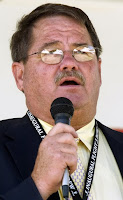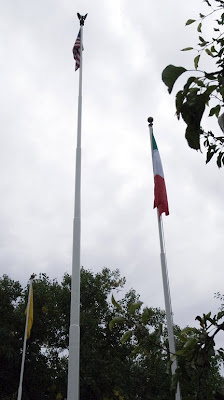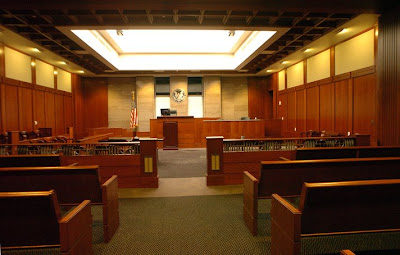Political blogger Marjorie Childress wrote a piece on her m-pyer site about Carter Bundy. Bundy wrote, as a guest columnist for Heath Haussamen’s site, about the Democratic Party’s system that is making selecting their presidential nominee difficult. Unlike the Republican’s winner-take-all primary system that has weeded out all but the presumptive candidate, Sen. John McCain, the Democrats’ top two candidates are mired in a knockdown drag-out fight process that may take them to the Denver convention without a clear winner.
So, what’s wrong with this picture?
 This is Bundy in the green American Federation of State, County and Municipal Employees sweat-shirt behind former President Bill Clinton, at a rally campaigning for his wife, at UNM’s Johnson gym on Jan. 30.
This is Bundy in the green American Federation of State, County and Municipal Employees sweat-shirt behind former President Bill Clinton, at a rally campaigning for his wife, at UNM’s Johnson gym on Jan. 30.Bundy fails to disclose his preference or support. What is a casual reader to make of Bundy’s comments if they don’t know where his leanings are?
Heath Haussamen has a spotty history of disclosure; sometimes he identifies his associations, like he did this week about being a friend of Democratic primary Congressional District 2 candidate Bill McCamley. However, he failed to disclose that Whitney Cheshire had been one of his weekly guest columnists, when he accepted a statement from her, in her new role as spokesperson for Heather Wilson’s campaign. Cheshire denied allegations of vote buying at the Bernalillo County Republican Party Pre-primary caucus. Haussamen, believing Cheshire, simply got the story wrong.
Childress raised an issue last week, which caused me to contact her. She was chastising my colleague, Joe Monahan, over his ethics essay winner. She wrote:
“…And to bring it full circle, here's a blog post by M.G. Bralley about one of those people who gave the bribes.”In an e-mail to Childress, I engaged her in a discussion, in part, on the ethics question and I wrote the following:
…A violation of law is a violation of ethics, but a violation of ethics is not necessarily a violation of law.She wrote back in a personal and casual e-mail:
There are a lot of things that people think should be violation of ethics that they will not codify.
If the law does not suffice, what makes you think that "ethics reform" will?
Don't get me wrong, there are some real problems here. However, just because the law is not used effectively does not mean there are no problems.
It seems that a great number of people think that money is the root of all ethical problems.
The Supreme Court determined that money is speech and protected….
…The reporting is completely backwards. Individuals should not be the ones named in legislation as being the ones limited. It should be the legislators and other elected officials who identify the source of every penny they accept.
Then, there needs to be a mechanism to track the money back. Armed with that information, voters will be informed better than they are now.
Every citizen a watchdog! Each person has a civic responsibility; not having time is not an acceptable excuse….
thanks for your note, and for correcting me. I had not had any coffee when I wrote that and you're right, you didn't say he bribed, just laid out the allegation. i fixed it on the blog, noting that you corrected me. in your post below you cover several different things:She added to her original post:
political ethics: would love to discuss this with you further, but at the moment am on the run. would love to discuss it in the comments section of my blog, as well, even if you wanted to do so anonymously.
my ethics: thanks for checking me on that. i do try, and don't mind being corrected when i overstep. i am far from perfect!
as to monahan, i agree with you: he's a big boy who has no problem taking care of himself. i thought my post was pretty reasonable, and my questions are valid considering his own posts on the topic.
**I have been taken to task by M.G. Bralley for misrepresenting what he said above. He has a good point--no bribery has been proven against that individual, and no charges brought, despite Montoya's statement. Thanks for checking me MGB. (By the way, m-pyre readers, the photo essays on Bralley's blogs are always interesting--you should all check them out).Like many bloggers I have encountered, Childress’ coffee depravation, (along with a lack of sleep) are the common excuses we use when we don’t quite get it right.
She corrected her posting and gave me a plug to boot. She redeemed herself with me.
So, I invited her to coffee, at her convenience, to talk government, politics, social issues, ethics, blogging, state of journalism, or whatever.....
No response from her yet; hence this post, to tell her that I appreciate her clear voice and thoughtful writing in the din of the blogesphere. I will take her up on the conversation, just not anonymously.

I do not engage in what I call the backside of blogging, or the comment section and I have only once made an anonymous comment. It was a smart-alecky poke at Sheriff Greg Solano’s objection to Moriarity Math Teacher Will Klundt who posed an arithmetic word problem. According to Solano’s source:
The “Just Say No!” types can’t stand any reference to drugs; I don’t hold such shallow thinking and believe that talking about drugs, even sarcastically, like other issues of the day, is a good thing. So I ventured in with an anonymous comment:
“Yeah! OK, but what's the answer?”
I think, even if no one else does, that it is important for the students to figure out the cost of doing drug related business, “the beat down.” It was possibly a missed opportunity to have a meaningful discussion on the negative economics of crime.
I’ve gotten a bit far a field. Back to the caffeine….
 Childress’ name has also appeared as a “Fellow” on The New Mexico Independent website that kicked off a couple of weeks ago.
Childress’ name has also appeared as a “Fellow” on The New Mexico Independent website that kicked off a couple of weeks ago.
The Independent is a new online news outlet sponsored by the nonprofit Center for Independent Media.
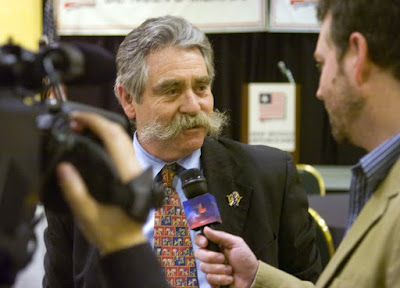 The Independent’s Managing Editor David Alire Garcia is a: former executive director of the State Democratic Party, a staff writer at the Santa Fe Reporter, on the editorial staffs at the Albuquerque Journal and Tribune, and co-host of PBS affiliate KNME TV’s weekly public affairs program, New Mexico In Focus. Alire Garcia, is seen above right, interviewing Robert Martinez after the State GOP’s pre-primary convention.
The Independent’s Managing Editor David Alire Garcia is a: former executive director of the State Democratic Party, a staff writer at the Santa Fe Reporter, on the editorial staffs at the Albuquerque Journal and Tribune, and co-host of PBS affiliate KNME TV’s weekly public affairs program, New Mexico In Focus. Alire Garcia, is seen above right, interviewing Robert Martinez after the State GOP’s pre-primary convention.
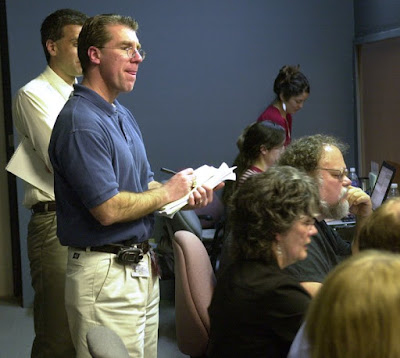 Former Journal political writer Trip Jennings, above center taking notes at the 2007 State Legislature, is the Independent’s News Editor.
Former Journal political writer Trip Jennings, above center taking notes at the 2007 State Legislature, is the Independent’s News Editor.
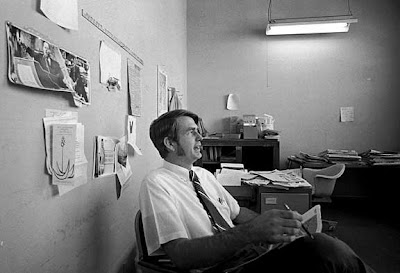 Despite the name, Independent, it does not resemble the old El Independente newspapers of the 1970s that were owned, published and edited by Mary Beth and Mark Acuff. Mark Acuff was a die-hard Democrat who had a notable career in New Mexico as a newspaper editor. He first gained notoriety as the UNM Daily Lobo’s editor in the early 1960s. I knew Acuff, above, when he was also the editor of the Albuquerque News in 1970 and 71. Acuff’s El Independente newspapers were not independent, but leaned, ever so slightly to the Democratic side, in spite of his fair reporting.
Despite the name, Independent, it does not resemble the old El Independente newspapers of the 1970s that were owned, published and edited by Mary Beth and Mark Acuff. Mark Acuff was a die-hard Democrat who had a notable career in New Mexico as a newspaper editor. He first gained notoriety as the UNM Daily Lobo’s editor in the early 1960s. I knew Acuff, above, when he was also the editor of the Albuquerque News in 1970 and 71. Acuff’s El Independente newspapers were not independent, but leaned, ever so slightly to the Democratic side, in spite of his fair reporting.
Usually, newspapers adopt names consistent with their political philosophy, such as: the Arizona Republic or the Arkansas Democrat-Gazette. The Independent website is also not so independent. The Center for Independent Media staffers tend to identify themselves politically as Progressives; so does Childress. Hence, the Independent might more aptly be named the New Mexico Progressive.
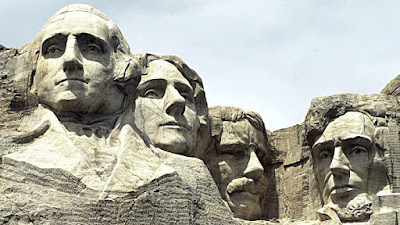 Now, I have some thoughts in common with the progressives. I consider one of the leading Progressive’s of the last century as someone I admire, the once police commissioner of New York City and later President, Theodore Roosevelt, who aptly is tucked away on Mount Rushmore amongst the truly great presidents.
Now, I have some thoughts in common with the progressives. I consider one of the leading Progressive’s of the last century as someone I admire, the once police commissioner of New York City and later President, Theodore Roosevelt, who aptly is tucked away on Mount Rushmore amongst the truly great presidents.
The Independent’s site intrigues me. The idea is something I hoped to be associated with; an online news source. They need some good photography. However, I am unlikely to join them, because upon reflection, their political leanings are in conflict with their masthead name.
OK, I admit that, “What’s Wrong With This Picture?” holds its own skewed editorial/political point of view. However, I don’t pretend to have the infrastructure of an established news outlet, but am a self-sustaining, single-minded source of news, commentary, analysis and opinion. If I joined such a group, I would adopt the currently accepted news standards of reporting and let a separate editorial section reveal the commentary, analysis and opinion. I attempt to follow the Society of Professional Journalists’ code of ethics in the reporting part of my postings. When it comes to the analytical portion, I tend to revert to the Public Administration school standards. Finally, “My Take,” is just that, pure opinion, hopefully informed, but mine just the same.
As an adjunct professor, I have only a few rules about discussion in the public square; Fact before opinion, respect the conversation, one at a time, and everybody plays. On my site I moderate comments, I seldom post anonymous comments, except those that truly add to the civil discussion. I believe in free speech, just not uncivilized rants. Everyone has a right to say what they want, but hecklers are invited to open their own sites and spew away. I had enough of street brawling and I get to choose how I wish to communicate. Comments are still welcomed.
In my photography, I adopt the conventional standards outlined in the National Press Photographers Association’s code of ethics.
I’m not sure I’m willing to give up my Marxist ways. No, not Karl Marx; but Groucho, who said, “I would not join any group that would have me as a member.”
"Smoky J. sells meth. Smoky's source says he has to sell a G's worth of meth by the end of the month. If Smoky sold $240 the first week and $532 the second week, how much money must Smoky make if he wants to avoid the beat down from his connection?"The teacher’s approach in mentioning drugs seemed to have upset some folks.
The “Just Say No!” types can’t stand any reference to drugs; I don’t hold such shallow thinking and believe that talking about drugs, even sarcastically, like other issues of the day, is a good thing. So I ventured in with an anonymous comment:
“Yeah! OK, but what's the answer?”
I think, even if no one else does, that it is important for the students to figure out the cost of doing drug related business, “the beat down.” It was possibly a missed opportunity to have a meaningful discussion on the negative economics of crime.
I’ve gotten a bit far a field. Back to the caffeine….
 Childress’ name has also appeared as a “Fellow” on The New Mexico Independent website that kicked off a couple of weeks ago.
Childress’ name has also appeared as a “Fellow” on The New Mexico Independent website that kicked off a couple of weeks ago.The Independent is a new online news outlet sponsored by the nonprofit Center for Independent Media.
 The Independent’s Managing Editor David Alire Garcia is a: former executive director of the State Democratic Party, a staff writer at the Santa Fe Reporter, on the editorial staffs at the Albuquerque Journal and Tribune, and co-host of PBS affiliate KNME TV’s weekly public affairs program, New Mexico In Focus. Alire Garcia, is seen above right, interviewing Robert Martinez after the State GOP’s pre-primary convention.
The Independent’s Managing Editor David Alire Garcia is a: former executive director of the State Democratic Party, a staff writer at the Santa Fe Reporter, on the editorial staffs at the Albuquerque Journal and Tribune, and co-host of PBS affiliate KNME TV’s weekly public affairs program, New Mexico In Focus. Alire Garcia, is seen above right, interviewing Robert Martinez after the State GOP’s pre-primary convention. Former Journal political writer Trip Jennings, above center taking notes at the 2007 State Legislature, is the Independent’s News Editor.
Former Journal political writer Trip Jennings, above center taking notes at the 2007 State Legislature, is the Independent’s News Editor. Despite the name, Independent, it does not resemble the old El Independente newspapers of the 1970s that were owned, published and edited by Mary Beth and Mark Acuff. Mark Acuff was a die-hard Democrat who had a notable career in New Mexico as a newspaper editor. He first gained notoriety as the UNM Daily Lobo’s editor in the early 1960s. I knew Acuff, above, when he was also the editor of the Albuquerque News in 1970 and 71. Acuff’s El Independente newspapers were not independent, but leaned, ever so slightly to the Democratic side, in spite of his fair reporting.
Despite the name, Independent, it does not resemble the old El Independente newspapers of the 1970s that were owned, published and edited by Mary Beth and Mark Acuff. Mark Acuff was a die-hard Democrat who had a notable career in New Mexico as a newspaper editor. He first gained notoriety as the UNM Daily Lobo’s editor in the early 1960s. I knew Acuff, above, when he was also the editor of the Albuquerque News in 1970 and 71. Acuff’s El Independente newspapers were not independent, but leaned, ever so slightly to the Democratic side, in spite of his fair reporting.Usually, newspapers adopt names consistent with their political philosophy, such as: the Arizona Republic or the Arkansas Democrat-Gazette. The Independent website is also not so independent. The Center for Independent Media staffers tend to identify themselves politically as Progressives; so does Childress. Hence, the Independent might more aptly be named the New Mexico Progressive.
 Now, I have some thoughts in common with the progressives. I consider one of the leading Progressive’s of the last century as someone I admire, the once police commissioner of New York City and later President, Theodore Roosevelt, who aptly is tucked away on Mount Rushmore amongst the truly great presidents.
Now, I have some thoughts in common with the progressives. I consider one of the leading Progressive’s of the last century as someone I admire, the once police commissioner of New York City and later President, Theodore Roosevelt, who aptly is tucked away on Mount Rushmore amongst the truly great presidents.The Independent’s site intrigues me. The idea is something I hoped to be associated with; an online news source. They need some good photography. However, I am unlikely to join them, because upon reflection, their political leanings are in conflict with their masthead name.
OK, I admit that, “What’s Wrong With This Picture?” holds its own skewed editorial/political point of view. However, I don’t pretend to have the infrastructure of an established news outlet, but am a self-sustaining, single-minded source of news, commentary, analysis and opinion. If I joined such a group, I would adopt the currently accepted news standards of reporting and let a separate editorial section reveal the commentary, analysis and opinion. I attempt to follow the Society of Professional Journalists’ code of ethics in the reporting part of my postings. When it comes to the analytical portion, I tend to revert to the Public Administration school standards. Finally, “My Take,” is just that, pure opinion, hopefully informed, but mine just the same.
As an adjunct professor, I have only a few rules about discussion in the public square; Fact before opinion, respect the conversation, one at a time, and everybody plays. On my site I moderate comments, I seldom post anonymous comments, except those that truly add to the civil discussion. I believe in free speech, just not uncivilized rants. Everyone has a right to say what they want, but hecklers are invited to open their own sites and spew away. I had enough of street brawling and I get to choose how I wish to communicate. Comments are still welcomed.
In my photography, I adopt the conventional standards outlined in the National Press Photographers Association’s code of ethics.
I’m not sure I’m willing to give up my Marxist ways. No, not Karl Marx; but Groucho, who said, “I would not join any group that would have me as a member.”













